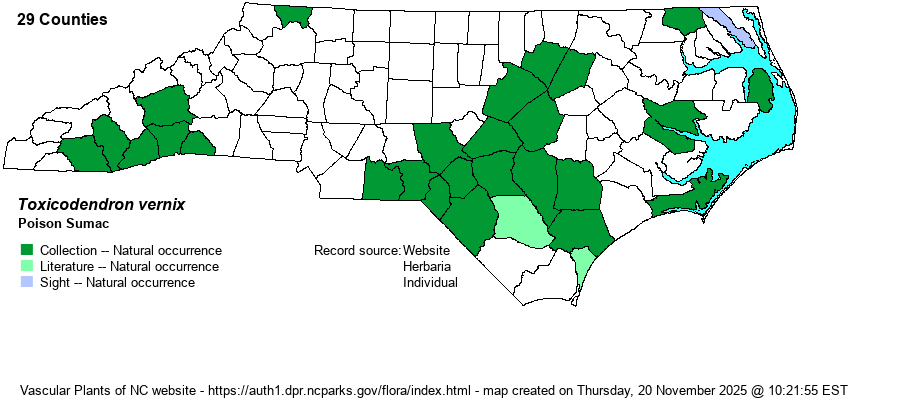| Author | (L.) Kuntze | |
| Distribution | Scattered over much of the Coastal Plain, though more frequent in the Sandhills region. Also scattered in lower portions of the Mountains, mainly near the SC/GA border and again along the VA border. Essentially absent from the Piedmont, except along the Fall Line (Anson, Wake, Franklin, and Nash counties). Absent from some Coastal Plain counties, especially so in the central and eastern counties.
The species is somewhat local or fragmented in range in the eastern U.S. and southeastern Canada. It ranges south to southern FL and eastern TX, but it is absent from IA, MO, and AR. It is also very scarce in the middle of the range (such as KY and TN).
| |
| Abundance | Fairly common to frequent in the Sandhills. Uncommon elsewhere in the southern Coastal Plain, north to Carteret and Johnston counties, but quite rare in the northern Coastal Plain and the extreme eastern Piedmont. Rare to locally uncommon in the southern Mountains (in wetlands/bogs). And very rare in the northern Mountains. | |
| Habitat | This is a strict wetland species, favoring acidic, peat-based sites, especially streamhead pocosins. It also occurs in acidic, wet thickets, margins of pocosins and bay forests, and in bogs and wet swampy places in the mountains. It is not a species of brownwater or rich wet areas such as most swamps and bottomlands. | |
| Phenology | Blooms in May and early June; fruits in August and September. | |
| Identification | Learn to identify this species, as it is a strongly poisonous plant if contacted. It is a tall shrub to very small tree, usually at least 10 feet tall and up to about 15 feet tall. The deciduous leaves have an average of 9-11 leaflets, which are elliptic yet entire on the margins, and averaging about 3 inches long. The leaf stalks are characteristically red or reddish in color, an important identification mark. Also note the small but many waxy white “berries” in drooping clusters in late summer and fall, at times persisting into winter. When you are walking along the margins of pocosins, bay forests, and streamheads, especially in the Sandhills, you must carefully look up or straight ahead, and not down, as you can easily bump your face into some leaves if you are unaware of its presence. Though the leaves strongly resemble ash (Fraxinus spp.) leaves, with many entire leaflets, the red leaf stalks are a “red flag” to stop and avoid the plant. In fall, the leaves turn a bright red, making them easier to spot than in spring and summer. | |
| Taxonomic Comments | Named as Rhus vernix until recent decades.
| |
| Other Common Name(s) | None. Note that this species is, indeed, a sumac species, and thus no hyphen is needed, though some references use “Poison-sumac”. On the other hand, Poison-ivy is not an ivy (Hedera) species, and thus it should be hyphenated and not written as “Poison Ivy”. Likewise, Poison-oak is clearly not an oak (Quercus), and thus it is not appropriate to name it without a hyphen as “Poison Oak”. | |
| State Rank | S4 | |
| Global Rank | G5 | |
| State Status | | |
| US Status | | |
| USACE-agcp | OBL link |
| USACE-emp | OBL link |

